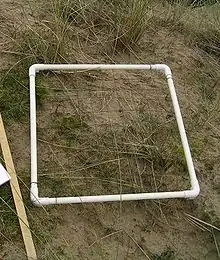
A quadrat is a frame, traditionally square, used in ecology, geography, and biology to isolate a standard unit of area for study of the distribution of an item over a large area. Modern quadrats can for example be rectangular, circular, or irregular.[1][2] The quadrat is suitable for sampling plants, slow-moving animals, and some aquatic organisms.
A photo-quadrat is a photographic record of the area framed by a quadrat. It may use a physical frame to indicate the area, or may rely on fixed camera distance and lens field of view to automatically cover the specified area of substrate. Parallel laser pointers mounted on the camera can also be used as scale indicators. The photo is taken perpendicular to the surface, or as close as possible to perpendicular for uneven surfaces.
History
The systematic use of quadrats was developed by the pioneering plant ecologists R. Pound and F. E. Clements between 1898[3] and 1900.[4] The method was then swiftly applied for many purposes in ecology, such as the study of plant succession.[5] Botanists and ecologists such as Arthur Tansley soon took up and modified the method.[6][7]
The ecologist J. E. Weaver applied the use of quadrats to the teaching of ecology in 1918.[8]
Method
A quadrat is used to methodically count organisms within a smaller, representative area in order to extrapolate to a larger habitat. The quadrat's size corresponds to the size of the organism being sampled and the overall sampling area.[9] Quadrats should be randomly distributed throughout the sampling area to avoid selection bias, a process that can be accomplished by assigning coordinates along a study grid to the sampling sites.[9]

Long-term studies require that the same quadrats be revisited after their initial sampling. Methods of precisely relocating the area of study vary widely in accuracy and include measurement from nearby permanent markers, use of total station theodolites, consumer-grade GPS, and differential GPS.[10]
See also
References
- ↑ Krebs, C.J. (1999). Ecological Methodology. Addison-Wesley.
- ↑ Wheater, C. Philip; et al. (2011). Practical Field Ecology: Project Guide. John Wiley and Sons.
- ↑ Pound, R.; Clements, F. E. (June 1898). "A method of determining the abundance of secondary species". Minnesota Botanical Studies. 2: 19–24.
- ↑ Pound, R.; Clements, F. E. (1900). Phytogeography of Nebraska (Second ed.). Lincoln, Neb. Published by the Seminar. pp. 61–63.
- ↑ Clements, F. E. (1916). Plant Succession. The Seminar, Lincoln, Nebraska. pp. 423–437.
- ↑ Oliver, F. W.; Tansley, A. G. (December 1904). "Methods of surveying vegetation on a large scale". New Phytologist. 3 (9–10): 228–237. doi:10.1111/j.1469-8137.1904.tb05867.x.
- ↑ Tansley, A. G. (1911). Types of British vegetation. Cambridge University Press.
- ↑ Weaver, J. E. (November 1919). "The Quadrat Method in Teaching Ecology". The Plant World. 21 (11): 267–283. JSTOR 43477708.
- 1 2 "Questions about Quadrats". Science and Plants for Schools. Retrieved 20 June 2018.
- ↑ Dodd, M. (2011). "Where are my quadrats? Positional accuracy in fieldwork". Methods in Ecology and Evolution. 2 (6): 576–584. doi:10.1111/j.2041-210X.2011.00118.x.